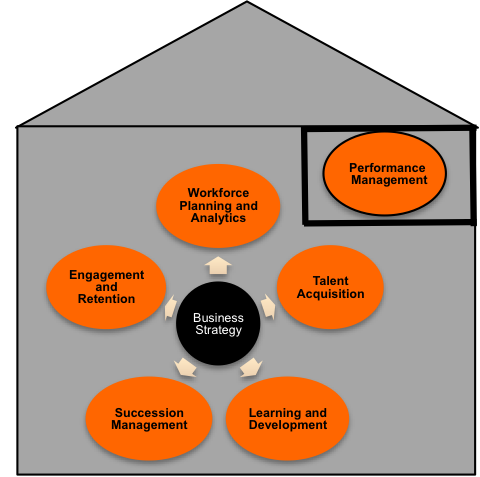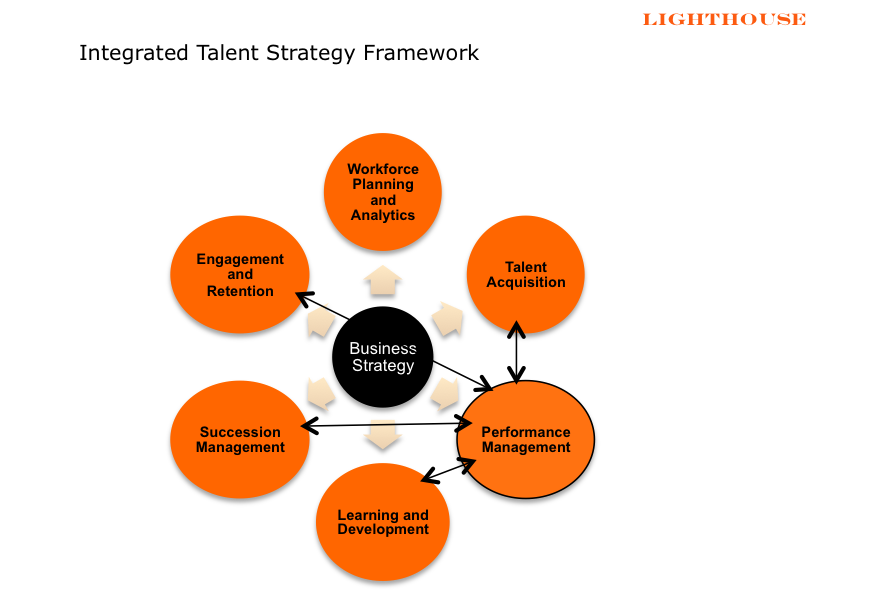The business process of performance management (PM) often seems like an isolated room within the “human capital” house (see figure below). The walls around the room appear opaque, with little visibility or clarity provided to a workforce that wants to understand what informs the performance management process and how the process aligns with other dimensions of one’s career.

Indeed, performance management continues to be one of the most disheartening and unfulfilling components of the people function. In a recent report from the Institute for Corporate Productivity, Performance Management: Still Waiting for Real Change, “seven out of ten respondents believed that their organization’s PM process is not managed well, and that it does not have a positive effect on performance”. Other findings find it highly administrative, archaic and outdated. According to Bersin by Deloitte’s 2015 Global Human Capital Trends, “performance management is being reinvented for a new, forward looking purpose: to serve as an efficient, focused business process that improves employee engagement and drives business results.” In the minority of organizations that get it right, performance management is a tremendous, value-rich component of the business and a catalyst for accelerated performance and growth. So how can we tear down the walls and connect this tremendously important discipline to the rest of the human capital framework?
Differentiating “performance”
One simple answer is to utilize the PM process to truly recognize superior performers. Rather than simply yielding to an annual, cascaded budgeting exercise that lands on a relatively meaningless and discouraging merit increase range of 2.4% to 3.0% for everyone, we can use thoughtful evaluations completed by conscientious managers. Those managers would assess performance against clear, strategically aligned goals and behavioral competency guideposts to create a wider dispersion among lower and higher performers (e.g. 0% to 5.0%). Similarly, we can annually examine and market test those pivotal or highly valued roles, as defined by our workforce planning process, and adjust salaries accordingly to better price those positions with more market or strategic value. Such a change will better integrate Performance Management with Engagement and Retention (see framework below) and establish more of a meritocracy-based culture.
Recognizing “potential”
Many organizations have moved away from forced rankings and, instead, have shifted to talent reviews. In this setting, leaders from all functions meet to identify those 20-25% of the workers, across the entire business, which have earned performance-based, discretionary bonuses. Why not use that same process to document and engage those individuals who have demonstrated the “potential” to move into new or emerging roles across the company? Then you can supplement annual review discussions with meaningful dialogue about career aspirations and alternative career ladders. Whether you call this exercise succession management or career planning, the benefit to the employee is that the evaluation is about performance AND about the performer. This extended focus on “potential” better links Performance Management to Succession Management and increases the possibility that valued members of your team will more actively and creatively consider career journeys they can have inside the company.
Bridging performance gaps with learning experiences
Regretfully, there is very little correlation between the performance gap(s) of an individual contributor in one year and the learning path that is designed for that individual in the coming year. The emergence of new learning technologies, social learning, and other modes of development have enabled talent to access more creative avenues for bridging performance gaps, yet this areas remains an underutilized strategy. Exploiting such options will better link Performance Management to Learning and Development and empower our workers to utilize training in its most optimal context – immediate, tied to a specific learning gap, and learner driven.
Articulating your performance culture
How consistent is the employee value proposition you present to a recruiting candidate with the actual Performance Management experience the person witnesses as a new hire? So often candidates are brought into an organization with a misunderstood picture of their earning potential or short-term promotion and leadership opportunities. The first performance review process feels disconnected from the unlimited possibilities shared only months earlier, and the employee is left feeling disillusioned and burned. Clearly discussing the organization’s approach to Performance Management will better link this importance discipline to Talent Acquisition by managing expectations and reducing unwanted attrition.
A company’s Performance Management process is not an uninvited houseguest, left to revel in paper forms and impersonal compliance-based assessments; rather, it is an essential part of the HR family with a rich source of date about how, why, and when employees perform their job. Such insight can fuel the engine of a well functioning talent management practice.


